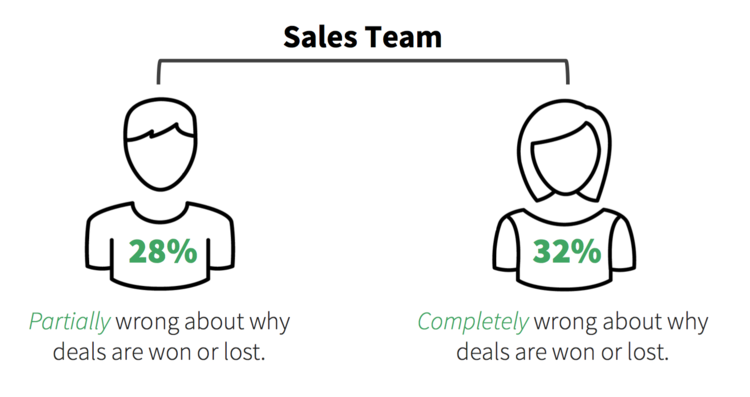Win-loss sales analysis is an essential practice for the modern, B2B sales organization. Understanding the recurring themes behind your wins and losses will enable you to take the corrective action needed to increase sales productivity and improve win rates.
Sales Talent is Scarce
To understand the importance of win-loss sales analysis, you have to take a step back and look at the general challenge that organizations face when it comes to hiring and optimizing sales talent. The Wall Street Journal reported, “Sales and sales-management positions play a critical role for U.S. businesses, but they are amongst the hardest to fill.”
This won’t surprise experienced sales leaders who know firsthand the challenges of hiring and developing quality sales talent.
Inadequate Sales Training = The Norm
Ironically, despite this shortage, most companies underinvest in training and developing the salespeople they already have – focusing on the quick fix rather than a long term investment. Even the most promising “natural seller” will fail miserably if her company fails to provide the knowledge, playbook, and resources that she needs to succeed.
Scott Edinger, author of Harvard Business Review article, “Sales Teams Need More (and Better) Coaching,” Scott Edinger wrote:
We hear constantly about the importance and value of coaching, especially in sales. But, the reality I have observed while working with hundreds of organizations, is that a true culture of coaching rarely exists.
He goes on to explain:
In a survey I conducted a few years ago with a sales team in a Fortune 500 telecom company, I found an interesting contrast. Leaders reported that they spent a considerable amount of time coaching their direct reports and scored themselves high on their efforts – on average, just shy of the 80th percentile. Direct reports responded by saying that they’d received little to no coaching from their leaders and scored them low — on average around the 38th percentile.
That disturbing trend begs the question, “How can companies improve their training and better develop their salespeople?”
Base Training on Win-Loss Interviews
An insightful answer to the above question comes from another Harvard Business Review article by Steve W. Martin titled, “What’s Wrong With Your Sales Training Program?” According to Martin, the number one problem with most sales training programs is that they are not based on feedback from the actual prospects and clients. He explains that:
You truly can’t train your sales team on how and why prospective customers make their buying decision if your training isn’t based upon direct interviews with decision makers at won and lost accounts.
Savvy sales leaders know the value of building their training programs on the foundation of buyer feedback. Leaders who invest in comprehensive win-loss programs uncover key insights that drive every decision they make – from sales training, to sales promotions, to product development. Surprisingly, however, only 20% of today’s businesses invest in establishing win-loss programs.
Whether ignorance, resources, or expertise are to blame, these organizations miss out on one of the most important opportunities for feedback and improvement. Rather than basing training and decision-making on direct buyer feedback, these companies have to rely on hearsay and intuition.
Meaningful insights from interviews with actual buyers at won and lost accounts will also resonate deeply with salespeople. There are few things that can make sales training more real and actionable than actual feedback from the buyers they have been selling to.
Most Reps Don’t Know Why They Win & Lose
Without access to legitimate buyer feedback, most organizations turn to their sales team for answers about why deals are won and lost. Unfortunately, sales reps are wrong about 60% of the time.

Many companies rely on the inaccurate feedback from their sales teams to draw conclusions about their products, competitors, and market – leading to suboptimal outcomes such as lower win rates, poor product development decisions, and longer ramp times for new sales employees.
Implementing a win-loss program is the simplest and fastest way to gain clarity into buyer decision-making. It also empowers the organization with the accurate data it needs to effectively train their sales reps, build better products, position those products more effectively, and win more deals.
Organizations that rally around the concept of buyer feedback and then follow through on an implementation of a win-loss program see amazing results. In the words of Stephane Rosenwald, the CEO of RV Conseil:
An investment in win-loss sales analysis will be rapidly paid back as it always leads to increased success rates.
Why Should My Sales Team Care About Win-Loss Sales Analysis?
- Increase Win Rates Boost sales team productivity, decrease new hire ramp time, and increase win rates.
- Verify Perceptions Perception is reality. Find out what buyers perceive to be your strengths and weaknesses. Does perception align with reality?
- Gain Competitive Insights Uncover key insights about your competitors and how you can differentiate what you offer.
Guide Product Development Don’t rely on instincts and knee-jerk reactions to guide product development. Use real data from actual buyers.





